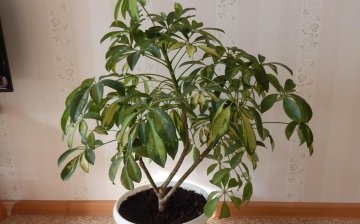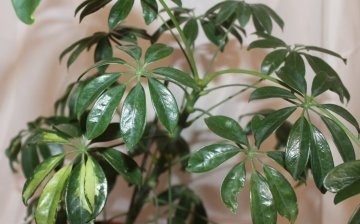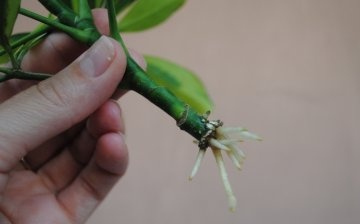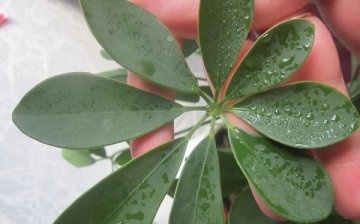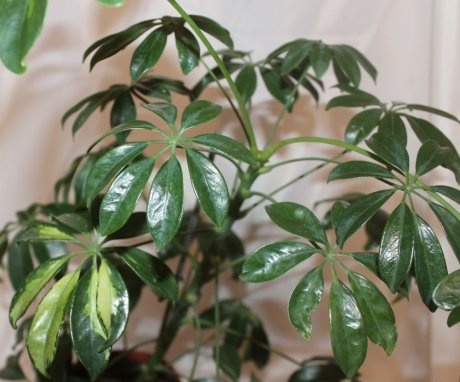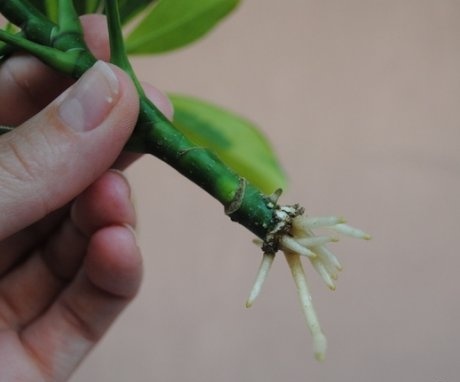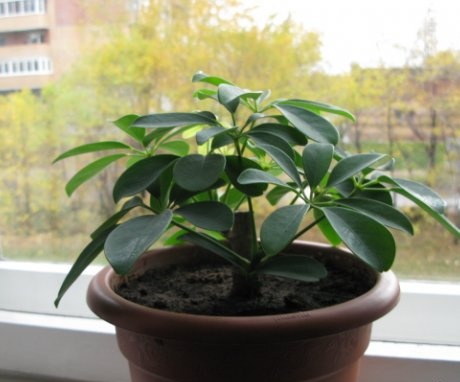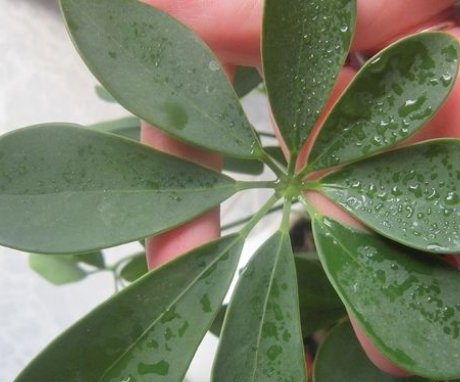Breeding cheflers: the best ways
Sheflera came to us from Taiwan. There it grows up to 2.5 m in height. At home - up to 1.5 m. There are undersized decorative varieties. It is valued for its beautiful, often variegated, leaves.
Content:
Description of chefs
The leaves of the cheflera are leathery, rounded, cut and lobes. Their length can reach 20 cm. The petiole is long. Leaves are green or variegated. Their surface is covered with light spots, stripes of white and yellow. As it grows, the lower leaves fall off, exposing the trunk. But the top ones create a beautiful crown. This plant is called the umbrella tree, because each of the leaves looks like a small umbrella.
In a year, the chief grows up to half a meter.
But for this you need a lot of heat and light in the room. Sheffler flowers are small, light green. They are collected in a panicle. It does not bloom indoors. For this she lacks light.
Variegated plants varieties:
- Gerda
- Sofia
- Gold Capella
- Trinette
- Janine
- Variety Janine - a miniature plant with a feathery leaf edge and white-yellow stains
- Amati - variety with green leaves
Reproduction methods
Propagated to the chefler by semi-lignified cuttings (the procedure is carried out in summer or spring):
- Cut off a stalk with 5 leaves with a sharp knife, cut off all the leaves except the top 2-3. You can cut off those that are immersed in water, and cut the remaining ones in half.
- The cuttings are placed in water with the addition of Kornevin, Heteroauxin or another rooting agent. You can use a mixture of sand and soil.
- A shelter is made from above, but a hole is left for ventilation. You can buy a special rooting greenhouse.
- If the room temperature is below 22 degrees, the dishes with the handle are placed on a warm surface. The soil is constantly moistened so as not to dry out.
- They make sure that direct sunlight does not fall on the leaves, the water in the glass does not evaporate, and the lump of earth does not dry out.
- After a couple of weeks, roots appear on the handle. It is planted in a separate bowl.
Propagated to the chefler by air layers. For this:
- The top layer is not cut deeply and the cut is covered with moss.
- Wrapped in polyethylene. Make sure that the moss does not dry out.
- After 2 months, roots are formed. The layering is cut off and planted in a separate bowl.
The chefler can also be propagated by seeds, but since it does not bloom in indoor conditions, it is difficult to use this method:
- If there are seeds, a light substrate is prepared from equal parts of leafy and sod land and sand, and it is sterilized. For half a day, the seeds are soaked in a stimulant solution (Epin, juice aloe).
- The seeds are small, so you need to close them up shallowly, by two of their lengths. Spray with warm water from a spray bottle. Cover with plastic wrap. Seeds sprout for a very long time, sometimes several months.
- After the seedlings have 2 or 3 leaves, their dive first time. After the transplant, the temperature is lowered to 18 degrees.
- When root system it will braid well with an earthen lump, transplanted again. The pots are taken small, up to 10 cm in diameter.
- The temperature is lowered to 15 ° C. Transplanted again, then the plant is considered an adult.
Plant care
Sheflera does not require much trouble. But in order for it to please with beautiful leaves, you need to create conditions for its development:
- Sheflera does not like cramped and dark corners. Therefore, you need to install it in an open, sunny place. Shefler should not start those who care for plants from time to time.
- She does not like strong hydration. Poor drought tolerance. Therefore, you need to water it regularly, but little by little, only after the earthen lump dries up from above.
- The plant reports excess moisture and insufficient lightingdropping leaves. In order for them to branch, they install the chefler in a bright place and stop watering often. If the clod of earth dries up, you can moisten it by placing it in water for 10 minutes. Then they wait for the excess water to escape and drain it from the pan. You can put gravel in a pallet and fill it with water, and put a pot with a flower on top.
- Sheflera responds well to spraying. It must be carried out with rain or settled water. If you use tap water, limescale will appear on the leaves. But even without spraying, it grows well. You don't just need to install it next to the radiator. A couple of times a year they wash the chef under the shower, covering the lump with plastic wrap. You can wipe the leaves with a damp cloth.
- It is better to install a pot with a sheflera on windowsills facing east or west. If they are narrow, they are placed near the window. The plant installed on the south window will need to be constantly shaded from the hot sunlight. If this is not done, light burn spots will appear on the leaves. Sheflera with variegated leaves, installed in an insufficiently lit place, will lose its bright coloring and its leaves will become monochromatic. To return the previous color, the plant is transferred to a lighter place, for example, to the southern window.
- The optimal temperature for growing in summer is considered to be 16-20 ° C. In winter, the room temperature should be lowered. But it shouldn't drop below 12 degrees. If there are drafts in the room or the leaves get cold air from the window, they may die. The maximum amount of light is needed in winter.
- Shefler reacts well to feeding. They are carried out liquid fertilizer, which can be bought at the store: Pokon +, Peat Oxidate, Novosil. It is better to reduce the concentration by 8 times, but water more often: once a week in summer, 2 times a month in winter. Dry fertilizers are not used for chefs.
- Sheflera is resistant to disease but can be damaged pests... This may be evidenced by dark spots on the leaves, their yellowing, blackening. The cause may be damage by thrips, scale insects, spider mites. You can fight with ready-made insecticides purchased at the store. In order not to use chemistry, you can treat the leaves and trunk with a solution of laundry soap.
Transplant and pruning
Shefler of low-growing varieties is transplanted after a year. For large ones, the time between transplants increases to 5 years. An indicator for transplanting can be roots that protrude from the hole of the pot. They take a little more dishes each time. The soil is prepared with neutral acidity, with the addition of sand and sphagnum moss. At the bottom of the dishes, drainage is laid with a thickness of at least 2 cm.It can be gravel, expanded clay. Adult chefs are transplanted by transshipment. This helps preserve the roots of the plant.
Sheflera is growing rapidly in comfortable conditions for her.
To stop it growing, the top is cut off at the desired height. The plant tolerates well pruning and forms a crown in the form of a ball. The shape of the plant can be chosen at your discretion: in the form of a tree, a bush. Sometimes several plants are planted in one pot and connected by braiding them with a pigtail.
From above it is fixed until the branches become coarse. Pruning causes vigorous growth of lateral shoots. They can also be trimmed to give the plant the desired shape. If the chef is irregularly watered, do not feed, do not cut, she can shed the leaves and even die.
More information can be found in the video:



